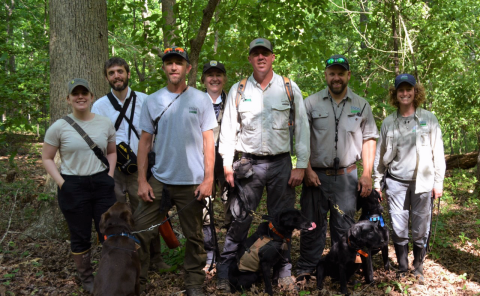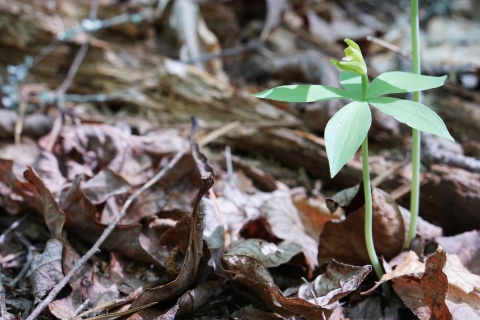As one of the rarest orchids east of the Mississippi, much of small whorled pogonia’s life and history remain a mystery.
Occurring sporadically from Maine to Georgia, the small whorled pogonia is named for its circular arrangement of five to six leaves around its stem. The orchid makes its home in older hardwood stands of beech, birch, maple, oak, and hickory trees with an open understory and a thick layer of dead leaves.
Standing 10-14 inches tall, the rare orchid blooms with a yellow-green flower just a few days out of the year, often skipping a year or two between blooms. The entire plant can remain dormant for up to 13 years without emerging from the leaves, making documenting it particularly difficult.
Highway construction projects, clearing forests for development, and wild pigs can easily destroy the sensitive sites where the small whorled pogonia is found. Additionally, predation from wildlife, like deer and rabbits, as well as illegal collection from orchid enthusiasts can pose a risk to smaller populations.
Since its listing under the Endangered Species Act in 1982, this orchid’s small "whorled" has slowly begun to grow. When listed only 33 populations of the rare orchid was known. Now that number has expanded well into the hundreds and in 2022, the federally threatened pogonia was discovered in Vermont for the first time in over 100 years.
Finding better ways to discover this cryptic plant is part of the challenge.
While its world may be expanding, we still have a long way to go in conserving the small whorled pogonia. In recent years, the Service and a multitude of partners throughout the Maine to Virginia range that surrounds the Appalachian Mountains region have begun researching new ways to detect this rare plant, and ultimately, learn more about how we can protect it.
In the mid-Atlantic portion of its range, detector dogs are hard at work sniffing out this pogonia. Partners from the Chesapeake Bay Detector Dog Program, U.S. Department of Agriculture APHIS Wildlife Service and U.S. Department of Defense, gathered their qualified K9s to train them to find these small, isolated plants.
Once found, biologists can study habitat and needs of this rare plant which must stay in the wild. It’s not as easy as sprinkling seeds and watering — all efforts to grow the small whorled pogonia in a greenhouse have been unsuccessful. These rare orchids are so sensitive that they cannot even withstand being transplanted from one location to another.
It will take a team of partners to figure out just what this fickle flower needs. Often referred to as a “goldilocks” species, conditions need to be just right for it to survive. For example, the small whorled pogonia needs sites with moist soil, but not soil that is too wet. It likes some sunlight hitting the forest floor, but not too much. The slope of the forest floor could be an important factor to its growth, or maybe not.
We know that careful management to increase light a bit can increase populations in the northeast. Botanists in the plant’s southern part of its range including researchers from the Smithsonian Environmental Research Center, State Heritage Botanists, and staff from Atlanta Botanical Garden are all working to discover its precise habitat conditions in the wild and how we might improve it.
One promising discovery by the Smithsonian Environmental Research Center, is the possible link between soil composition and fungi to the success and growth of the small whorled pogonia. Soil fungi could play a nutritional role in feeding the orchid while it remains dormant in the ground, or even snap the plant out of dormancy.
It’s also possible that this mid-succession forest orchid, (one that neither thrives in newly formed forests nor older, mature forests) could be waiting to emerge when a nearby tree falls to the ground. The small whorled pogonia could be taking advantage of the rich soil formed from the tree’s decomposing root system as well as the increased light provided by the new canopy opening, or when its conditions are just right.
Until we learn more about this federally threatened orchid, it’s important to recognize that we couldn’t decipher this mysterious, conservation puzzle without the dedication of our conservation partners and the work they do to protect threatened and endangered species. Today, hundreds of rare species are stable or improving thanks to the management actions of Tribes, federal agencies, conservation organizations, and private citizens.






